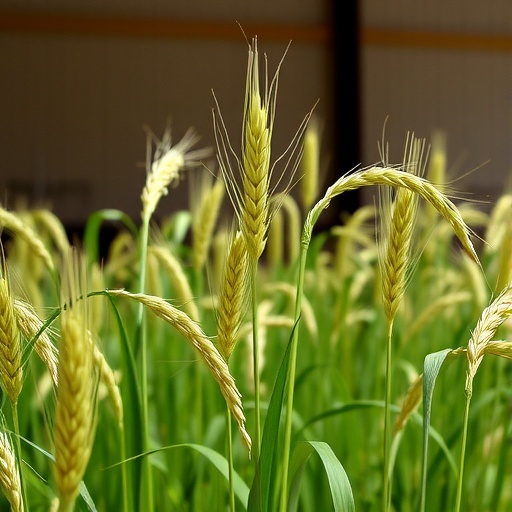In recent years, the search for sustainable and efficient methods of biofuel production has gained monumental importance, owing to the urgent need for alternative energy sources that can mitigate the effects of climate change. Among the promising avenues for biofuel generation is the utilization of agricultural residues, particularly wheat straw, which is often discarded after harvesting. Recognizing this potential, a groundbreaking study led by Poomani et al. explores the fermentation efficiencies of the non-conventional yeast Pichia kudriavzevii SVMS2019, specifically in relation to hexose and pentose sugars derived from pretreatment processes applied to wheat straw biomass.
In the modern world, where traditional fossil fuels dominate energy consumption, researchers are increasingly turning to biomass as an invaluable resource. Wheat straw, a byproduct of wheat production, is not only abundant but also rich in cellulose and hemicellulose—a fact that positions it as an ideal candidate for fermentative processing. The study presents a sophisticated investigation into maximizing the fermentation efficiency of non-conventional yeasts, which possess unique metabolic pathways that could enhance the conversion of these sugars into biofuels.
At the core of this research is Pichia kudriavzevii, a yeast species with remarkable fermentation capabilities. Unlike its more commonly used counterparts, such as Saccharomyces cerevisiae, Pichia kudriavzevii demonstrates a distinct ability to ferment both hexose and pentose sugars, the two primary constituents derived from biomass degradation. This dual capability makes it particularly effective in utilizing the full spectrum of sugars released during the pretreatment of lignocellulosic biomass, significantly improving the overall yield of fermentable sugars—an essential step in bioethanol production.
The pretreatment of wheat straw is a critical step in unlocking its fermentable potential. Traditional methods often involve physical, chemical, or biological processes to disrupt the lignin-carbohydrate matrix, thus enhancing cellulose accessibility for enzymatic hydrolysis. In this research, a classic pretreatment method was applied to optimize the release of both hexose and pentose sugars, allowing the yeast to achieve high fermentation rates. The meticulous methodology employed in this study not only reflects rigorous scientific exploration but addresses the pressing need to enhance the economic viability of biofuel production from waste materials.
The findings of Poomani et al. reveal a significant leap in fermentation efficiencies when Pichia kudriavzevii was exposed to pretreated wheat straw. The yeast’s adaptability in utilizing diverse sugars enables a more nuanced approach to fermentation, where the simultaneous fermentation of multiple sugar types reduces the time and resources typically required to achieve high yields. This highlights the importance of selecting the right microbial strains for biofuel production—a factor that can make or break the success of large-scale biofuel operations.
Moreover, the research sheds light on the metabolic pathways activated in Pichia kudriavzevii during fermentation. Understanding these pathways is crucial, as they not only dictate the efficiency of sugar conversion but also influence the byproduct profiles generated during fermentation. This insight opens up further avenues for optimizing fermentation processes to reduce byproduct formation and increase the purity of the end biofuel product.
A comparison of the fermentation profiles for hexose and pentose sugars indicates that the yeast demonstrated a preferential uptake pattern, which further aids in optimizing fermentation parameters. Detailed kinetic studies revealed distinct variations in fermentation rates contingent upon the sugar composition present in the media. This aspect of the research provides critical data that can inform bioprocessing strategies aimed at maximizing efficiency and scalability.
The implications of this study extend beyond mere academic interest; they portend significant advancements in industrial biofuel production. By validating the fermentation capabilities of Pichia kudriavzevii, this research paves the way for utilizing non-conventional yeasts in commercial biofuel operations. Such an approach could potentially lower production costs associated with enzyme supplementation, which is often a hindrance in large-scale biofuel production.
Furthermore, the careful balancing of fermentation conditions, such as pH, temperature, and nutrient availability, resulted in optimized performance metrics for Pichia kudriavzevii. These findings serve as critical guidelines for future researchers and industry stakeholders looking to harness the power of microbial fermentation in transforming agricultural waste into viable energy solutions.
In light of the growing necessity for sustainable energy practices, studies like this one are essential for driving innovation. They provide a foundational understanding of how to effectively harness microbial capacities for industrial applications, thus encouraging the shift towards biobased economies. The incorporation of agricultural residues, particularly wheat straw, into biofuel production represents a decisive step towards achieving a circular economy—where waste is transformed into valuable resources.
Overall, the work of Poomani et al. casts a spotlight on the profound potential of combining advanced fermentation techniques with powerful microbial agents. As the world grapples with energy challenges, the outcomes of this research may catalyze further explorations into harnessing biomass for biofuels. It exemplifies a shift in paradigm, illustrating how science can intersect with environmental stewardship to pave the way for a sustainable future.
In conclusion, by delving into the intricacies of fermentation efficiencies in Pichia kudriavzevii, this study significantly contributes to the ongoing discourse about renewable energy. It emphasizes the importance of not only improving existing processes but also innovating new methods to optimize biomass utilization. As researchers continue to uncover the capabilities of non-conventional yeasts, we stand on the brink of advancements that could define the future of clean energy.
Subject of Research: Enhanced fermentation efficiencies of Pichia kudriavzevii using pretreated wheat straw biomass.
Article Title: Enhanced Non-Conventional Yeast Pichia kudriavzevii SVMS2019 Fermentation Efficiencies with Hexose, Pentose and Classic Pretreated Wheatstraw Biomass.
Article References: Poomani, M.S., Mariappan, I., Balasubramanian, K. et al. Enhanced Non-Conventional Yeast Pichia kudriavzevii SVMS2019 Fermentation Efficiencies with Hexose, Pentose and Classic Pretreated Wheatstraw Biomass. Waste Biomass Valor (2025). https://doi.org/10.1007/s12649-025-03253-9
Image Credits: AI Generated
DOI:
Keywords: Biofuel production, Pichia kudriavzevii, wheat straw, fermentation efficiency, biomass utilization.




